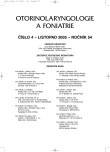Shaver (Microdebrider) in Otorhinolaryngology
Authors:
J. Vokurka
Authors‘ workplace:
Klinika ušní, nosní a krční LF UK a FN, Hradec Králové
přednosta doc. MUDr. J. Vokurka, CSc.
Published in:
Otorinolaryngol Foniatr, 54, 2005, No. 4, pp. 175-186.
Category:
Comprehensive Reports
Overview
Summary:
In the end of 90ties of the last century a new tool appeared in rhino surgery and rapidly spread out to workplaces performing rhino surgery operations by the technique of functional endoscopic surgery. It is a system of two hollow knives, one inserted into the other, while the inner one rotates inside the other. The cavity of the knives is connected with an exhauster. Due to the suction opening of the window follows to sucking of soft tissues, which are detached by the rotating knife and transported to the exhauster. The tool called shaver or microdebrider is mostly used for ablation of soft tissues, the application in rhino surgery being for polyps, hypertrophic mucosa, tumors, less suitable for the removal of osseous structures. The gradual development of the construction of knives of the shaver extended the indications to their application for aggressive intervention or, conversely, to fine ablation. Special knives enable resection of certain structures (a knife for uncinectomy) or contribute to safety of surgical procedure *a knife for ethmoidectomy protected toward the rear). The bone structures can be operated on by shaver-milling machine of various shapes. The purpose determines the properties – a spherical shape for sphenoidotomy or ethmoidectomy, a bent longitudinal for trepanation in the area of the outlet of frontal cavity etc. Two factors are most important for efficiency of the shaver – negative pressure created by the exhauster and sharpness of the knives or milling machine. The revolutions (per minute) are not so important. For the ablation of soft tissues the oscillation working modus proved to be most efficient, and the rotation modus for the milling. There are presently various kinds of shavers on the market and the paper compares five different systems provided by different companies. The supply offered by different companies in the last years has become similar, but the development continues. In connection with endoscopic endonasal surgery the shaver proved to be a useful tool also for the fact that it integrates two tools in one – the exhauster and the knife for removal of the tissues. This property eliminates one-handedness of the surgeon operating on with the use of endoscope. The aggressiveness of the shaver requires practice in order to make the surgery safe and non-complicated. After mastering of the operation technique the surgeon can perform very fine and considerate interventions such as ablation of superficial layers of thickened (incrassate) mucosa for preservation of basal layer, it is possible to form small anthrostomy virtually in the range of natural primary ostium of maxillary cavity (small hall technique). The interventions have become even less invasive than with the application of classical instruments for functional endonasal surgery as far as the structures which should be saved are concerned, and may be radical and more exact in removing pathological tissues. New constructions of bent knives and milling machines increase availability of pathological changes in paranasal cavities, which may removed from endonasal approach under endoscopic control. This approach can even better fulfill the concept of endonasal surgery as far as the treatment of rhinosinusitis is concerned. In operations which are not directed to treatment of inflammation, but make use of endoscopic instruments and endonasal approach, the shaver extends the possibilities and improves the comfort of the surgeon. These interventions include operations on lacrimation pathways (DCRS) decompression of eye socket and visual nerve, operation on cranium base, operation on nasopharynx, etc. There are ever emerging possibilities for the application of shavers as well as construction of new systems and innovation of older ones which demonstrate that the tools and the operation techniques are still in a state of dynamic evolution. It is also of considerable importance that the shaver substitutes various other tools in endonasal surgery and supplements the other in a suitable way. The application of shavers in microlaryngosurgery is of interest and awaits more extensive usage as well as in rhinoplasty, reduction of lymphoepithelial tissue of palatinal tonsils (intracapsular tonsillectomy).
Key words:
shaver, microdebrider, functional endonasal surgery.
Labels
Audiology Paediatric ENT ENT (Otorhinolaryngology)Article was published in
Otorhinolaryngology and Phoniatrics

2005 Issue 4
Most read in this issue
- Xerostomia: Etiology, Therapeutic Possibilities, Recommendation to Patients
- Shaver (Microdebrider) in Otorhinolaryngology
- Langerhans‘ Cell Histiocytosis and Its Manifestation in Temporal Bone (Eosinophilic Granuloma of the Temopral Bone)
- Cholesteatoma and Fistula of Bone Labyrinth
